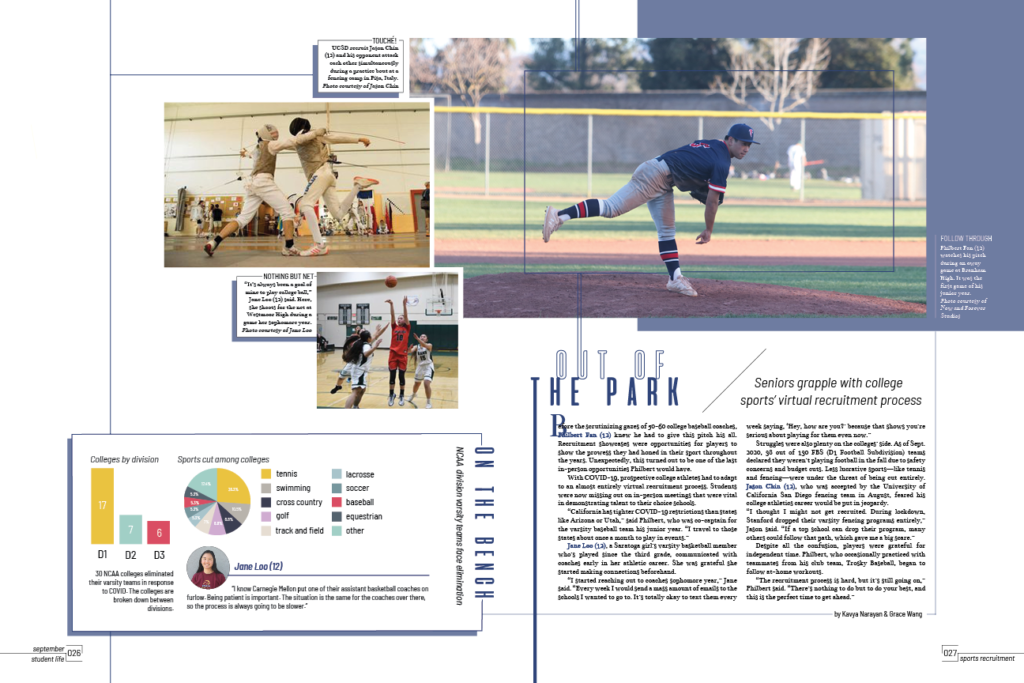Every Tuesday and Friday morning, after announcement in Zoom, 22 students hop onto various Discord voice channels. But instead of gaming, they discuss stories and design pages for the school’s 2020-2021 yearbook: Talisman 61.
This year’s remote nature has posed several challenges for the yearbook staff, especially since they no longer have access to Adobe programs and fellow staff members in the journalism room.
One of the book’s four editors-in-chief, senior Tiffany Huang, sees the biggest challenge as the process of signing off page layouts. In the past, editors would physically be at designers’ computers to point out changes to correct. This year, however, they must set up a time on Discord after class to walk through the process before the designer sends the corrected layout to the editors for double checking.
“This has made the entire process so much longer than it would be in person,” Huang said. “It can be pretty frustrating.”
Another source of frustration for the yearbook staff has been getting the Adobe programs that had been available on school computers working on personal devices. Last spring, the school district decided to purchase the Adobe Creative Cloud license for students in programs such as journalism and MAP, allowing these students to use the Adobe apps at home for free this year.
But using these programs is no small task, as sophomore Kiana Compeau has found out.
“The online class is considerably harder for new staff members,” Compeau said. “We had to download all of the Adobe apps, fonts, templates and libraries onto our computers. If we needed help with the layouts or software, it was really hard to navigate through the issues.”
This problem is especially significant because the yearbook staff consists of only 22 students, the fewest in the past two decades. To lessen the burden, newspaper staff members will be helping out with spreads (two pages that face each other); even so, many yearbook students need to work individually instead of in their usual pairs.
But for yearbook adviser Michael Tyler, the foremost challenge is the lack of photos. Traditionally, the most compelling parts of the yearbook are the thousands of photos of school-wide events like Homecoming and football games.
“Those great photos that we'd often put on a divider page or the inside of the cover just don't exist this year,” Tyler said. “Everything is a Zoom array, and it's not a lot of fun.”
Junior Kavya Narayan, a photographer, is responsible for photographing the ins and outs of people’s lives right now; however, getting photos of natural human interactions has been especially difficult this year.
“Our best bet in solving this problem is to go to new places and get as many photos of the city as possible,” Narayan said. “This ranges from people waiting in line outside of Starbucks to students picking up their books from the textbook room.”
Tyler believes the lack of photos is the most difficult situation he’s faced in 24 years of being an adviser. He hopes photo opportunities will arise in December with the start of sports, but nevertheless, he expects this yearbook to be less of a photography book and more of a content-based book.
In response to the lack of photos during online school, editor-in-chief Wilson Fung created a Talisman 61 Instagram account to promote the Yearbook Snap app, which allows students to share their own photos.
“When you log into the app, you would sign up to SHS, and then you can upload photos that we can use,” Fung said. “It’s helpful for us since we might need to rely on donated photos, and finding and accrediting those photos would be a lot easier with Yearbook Snap.”
The Instagram account, which currently has 380 followers and is still growing, will also allow students to receive information they might miss on the school’s Facebook page, which only has about 600 members.
Although a lot is being done by the Yearbook staff to obtain photos, Huang believes the book will rely a lot more on design, graphics and journalistic reporting.
“Reading the yearbook will be a very visual experience, even more so than previous years,” Huang said.
Additionally, the book will be built chronologically by month, unlike its usual predetermined structure of putting spreads, such as senior portraits, at certain page numbers. Students may return to school later in the year, which will open up more opportunities for photos in the later parts of the book.
Despite the challenges, Huang said she has confidence in the book, especially after seeing some of the finalized spreads coming out the way she envisioned it.
She said she is especially proud of the theme she and her fellow editors-in-chief chose — staff members usually try to keep it a secret until the book debuts — since it allows the book to focus on individuals through a new lens.
Unfortunately, only 320 yearbooks have been sold so far compared to the 765 sold by this time last year, and over a 1,000 sold by this time of previous years. Without more sales, the length of the book will need to be cut, Tyler said.
But Tyler said he sees great value in this yearbook because it will contain the stories of people going through this historical year. He is working to push for more publicity.
“The pandemic doesn't change journalists,” he said. “They are professional storytellers, so even in the worst of times — especially in the worst of times — there are interesting and compelling stories to tell.”

























